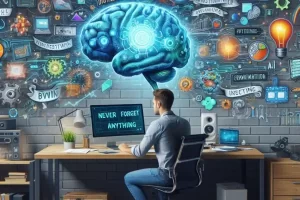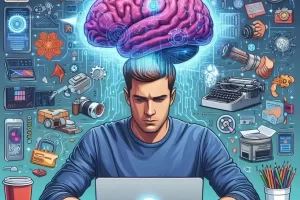Journaling is one of the most powerful tools for personal growth, self-awareness, and emotional clarity. But many people struggle to maintain a consistent journaling habit, or they write without knowing how to reflect on what they’ve written. That’s where your second brain, enhanced by artificial intelligence (AI), becomes a game-changer.
In this article, you’ll learn how to use your second brain to develop a digital journaling practice, and how AI can help you reflect, recognize patterns, and grow over time — all from within your own thoughts.
Why Journaling Is Essential for Growth
Journaling helps you:
- Process thoughts and emotions
- Clarify decisions
- Capture meaningful moments
- Track patterns and progress
- Reduce stress and mental overload
But traditional journaling lacks structure and review. Most people:
- Don’t re-read old entries
- Don’t connect ideas across time
- Don’t act on what they discover
That’s where AI adds depth, intelligence, and follow-through.
Create a Journaling Dashboard in Your Second Brain
Start by building a space in Notion, Obsidian, or Tana specifically for journaling.
Your dashboard can include:
- Daily entries
- Weekly reflections
- Emotional check-ins
- Gratitude list
- Lessons learned
- Prompts and quotes
Set up a recurring template with fields like:
- What did I feel today?
- What energized or drained me?
- What am I proud of?
- What am I worried about?
- What do I want to remember?
You can also voice-record entries and use Otter.ai or Notion AI to transcribe them.
Use AI Prompts to Enhance Your Journaling
AI can help guide your writing with personalized prompts based on your goals or recent activity.
Try:
“Generate a journaling prompt for someone feeling unmotivated.”
“What should I reflect on based on my past 5 entries?”
“Ask me 3 questions that help me think deeper about today’s events.”
You can also use ChatGPT to create a custom daily prompt generator or journaling chatbot tailored to your life themes.
Reflect on Past Entries Using AI
Most people never look back at their journal entries. But with AI, your second brain can analyze your emotional trends and mental patterns.
Prompts:
- “Summarize my journal entries from this month.”
- “What emotions appeared most often in the last 30 days?”
- “What themes have I written about repeatedly?”
- “Are there any decisions I’ve been delaying or avoiding?”
This turns your journal into a mirror of your inner world, not just a diary.
Track Emotional and Mental Patterns Over Time
Use tags like:
- Mood
- Focus level
- Stress
- Gratitude
- Energy
With AI:
- Detect correlations (e.g., “I’m more focused on days I sleep 7+ hours”)
- Spot recurring words or tone shifts
- Visualize emotional journeys across weeks or months
Prompt:
“Analyze the sentiment of my journal entries this week.”
“Which topics tend to trigger negative emotions?”
“What’s my general mindset trend this month?”
This helps you become proactive about your mental health and emotional resilience.
Turn Reflections into Growth Plans
Great reflection leads to action. Use AI to convert your insights into habits or projects.
Prompts:
- “What habits should I adopt based on last week’s struggles?”
- “Create a weekly plan to improve my energy and focus.”
- “What should I stop doing, based on my recent reflections?”
Your second brain helps you apply your self-knowledge in daily life.
Add a Gratitude Practice with AI Support
Gratitude rewires your brain for positivity and balance. Add a section in your journal template for:
- What made me smile today?
- Who am I thankful for?
- What simple things brought me peace?
Ask AI:
“Help me list 3 things to be grateful for today, based on my notes.”
“What patterns of gratitude do I see over the past 10 entries?”
Over time, you build a record of joy and appreciation, even during difficult seasons.
Use Weekly and Monthly Reviews for Deep Reflection
At the end of each week, ask:
- What went well?
- What was difficult?
- What did I learn about myself?
- What needs to change?
AI can generate summaries and even suggest next steps:
“Summarize my wins and challenges this week.”
“Based on this month’s journal, suggest one focus area for personal growth.”
These reviews help you see progress over time, not just react day to day.
Real-Life Example: A Personal Growth Tracker
Let’s say you’re building emotional resilience. Here’s how your second brain helps:
- You journal daily using voice notes and a template
- AI transcribes and tags each entry by mood and theme
- Every week, ChatGPT summarizes what’s working and what’s not
- It detects that most of your stress is triggered by lack of boundaries at work
- You create an action plan to improve that one area
- The next month, AI notes a significant drop in negative emotions
Now your journaling isn’t just emotional release — it’s a transformational tool.
Final Thoughts: Grow Deeper, Not Just Smarter
Your second brain can hold more than facts and tasks — it can hold your truth, your growth, and your humanity.
With the support of AI, journaling becomes more than writing. It becomes a process of emotional intelligence, personal alignment, and deliberate transformation.
You don’t need to journal for hours. Just be consistent, stay open, and let your second brain reflect you — and grow with you.




